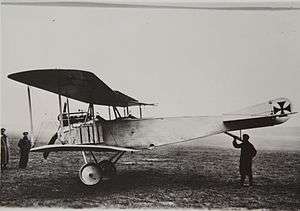Albatros B.III
| B.III | |
|---|---|
 | |
| Role | reconnaissance |
| National origin | Germany |
| Manufacturer | Albatros Flugzeugwerke, Oeffag, OAW |
| Designer | Ernst Heinkel |
| Developed from | Albatros B.II |
The Albatros B.III was a German World War I reconnaissance biplane, built by Albatros Flugzeugwerke.
Development and design
The Albatros B.III was the last of the company's unarmed reconnaissance two-seaters and was a precursor to the most important of their armed reconnaissance biplanes, the C.III.
The changes from the previous versions were fairly minor. It introduced what would become the typical Albatros tail when the rudder was rounded off. It was otherwise similar to the B.II. The B.III was produced in small numbers during 1915, but it was already clear that reconnaissance aircraft needed to be armed. Albatros then produced the C.I, which was based on the earlier B.II, and then moved onto the C.III. With some additional detail changes the Albatros C.III was basically an armed version of the B.III, although few parts remained interchangeable between the two aircraft.
Variants
- Albatros L.5 - post-war manufacturers' retroactive designation
Operators
Units using this aircraft
FEA 6
Specifications
Data from [1]
General characteristics
- Crew: 2
- Length: 7.8 m (25 ft 7 in)
- Wingspan: 11 m (36 ft 1 in)
- Height: 3.15 m (10 ft 4 in)
- Wing area: 40.12 m2 (432 ft2)
- Empty weight: 723 kg (1,594 lb)
- Gross weight: 1,071 kg (2,361 lb)
- Powerplant: 1 × Mercedes D.II inline piston or 1 Daimler D I, D II, Argus As II or Bz III, 90 kW (120 hp)
Performance
- Maximum speed: 120 km/h (75 mph)
- Endurance: 4 hours
- Service ceiling: 3,000 m (9,840 ft)
Armament
- None
See also
- Related development
- Aircraft of comparable role, configuration and era
- AEG B.I
- AEG B.II
- AEG B.III
- Aviatik B.I
- Aviatik B.II
- Aviatik B.III
- DFW B.I & II
- LVG B.I, II & III
- Rumpler B.I
- Related lists
- Idflieg aircraft designation system
- List of military aircraft of the Central Powers in World War I
- List of military aircraft of Germany by manufacturer
References
Bibliography
| Wikimedia Commons has media related to Albatros Flugzeugwerke. |
- Gray, Peter; Thetford, Owen (1962). German Aircraft of the First World War. London: Putman.
- Taylor, Michael J. H. (1990). Jane's Fighting Aircraft of World War I. London: Studio Editions. p. 141.